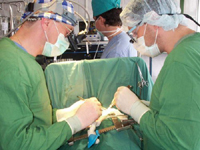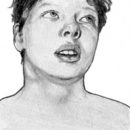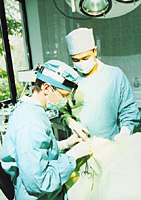How is the operation on the thyroid gland? What does a surgeon doing and what feels a patient during surgery? Answers to these questions you will find in the article.
Content
Thyroid Operation
So, any operation on the thyroid gland involves the following steps:
Preoperative ultrasound examination thyroid gland produced by the operating surgeon. It should be emphasized that an experienced surgeon will never start an operation without examining independently before the intervention is the location of the internal structures, the localization of the tumor, the condition of lymph nodes in the operation zone.
Skin marking on the neck In order to obtain a beautiful, symmetrically located, smooth scar. High-quality planning of the future seam in operating conditions when the patient is in a state of anesthesia on the operating table, almost impossible - the seam will surely be the crooked, which will deteriorate the cosmetic result of the operation.
Anesthesia. Currently, all specialized clinics of endocrine surgery operate only in conditions of general anesthesia (anesthesia). Qualitatively conducted anesthesia allows you to eliminate all the unpleasant sensations in the patient, and also provides the convenience of the surgeon.
 Skin cut. Marking lines applied to surgery. The length of the cut depends on the type of disease, the size of the thyroid gland, the need for lymphodissection. On average, the incision during the operation can be from 2 cm (with a video solitary thyroidectomy) to 15 cm (when performing a complete removal of the thyroid gland with the removal of side lymph nodes of the neck).
Skin cut. Marking lines applied to surgery. The length of the cut depends on the type of disease, the size of the thyroid gland, the need for lymphodissection. On average, the incision during the operation can be from 2 cm (with a video solitary thyroidectomy) to 15 cm (when performing a complete removal of the thyroid gland with the removal of side lymph nodes of the neck).
Dissemination of the thyroid gland. It is carried out either with the intersection of short muscles of the neck (with very large tumors), or without it (the muscles in this case are simply bred to the sides). In specialized clinics, the overwhelming majority of operations on the thyroid gland are produced without crossing muscles - it provides less pain after the operation, the postoperative swelling decreases, allows the patient to restore mobility faster.
The intersection of thyroid vessels. Usually the first to be tied up and the vessels of the top pole of the gland are intersect. At this point, the surgeon conducts events to prevent injury of the outer branch of the upper gentle nerve.
Selection of return nerve. The thyroid gland shifts to the trachea, after which the surgeon finds and highlights a return nerve from the lower pole of the gland to the nerve inlet to the larynx.
Department of Porish-shaped iron. Simultaneously with the release of the nerve, the surgeon separates the porous glands from the thyroid, while maintaining their blood supply.
Removal of the lobe of the thyroid gland with the subsequent crossing of the transfer. At this stage, the surgeon bandages and crosses the remaining vessels, after which it completely removes the fraction of the thyroid gland.
Removal of the second share of the gland (if necessary) - is carried out by a similar scheme.
Lymphodissection (removal of lymph nodes and their fiber surrounding) - is carried out if necessary. Recently, more and more often with any operations over the thyroid cancer, surgeons are resorted to central lymphodissection.
Neck muscle crosslinking with leaving drainage. Most often after the operation on the thyroid gland to the place where it was located, a flexible silicone tube is supplied, connected to vacuum suction. During the first day, this system removes blood residues from the bed. The use of soft silicone tubes of the Blake system allows you to reduce soreness in the first day after the operation, as well as make the subsequent removal of the drainage low-onedic.
Cosmetic seam overlay. It can be carried out using non-disseminating materials (seams are removed after wound healing), absorbable materials (removal of the seam is not required), or by glueing the skin with Dermabond glue.









